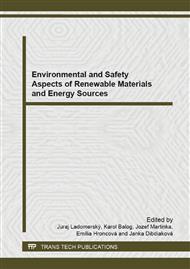[1]
S.J. Pyne, P.L. Andrews, R.D. Laven: Introduction to Wildland Fire. New York: John Wiley & Sons, New York. (1996).
Google Scholar
[2]
J. Tuček, A. Majlingová: Lesné požiare v národnom parku Slovenský raj: Aplikácie geoinformatiky. [Forest fires in National Park Slovensky raj: Application of Geoinformatics]. Technical University in Zvolen, Zvolen, 2007. 173 s., ISBN 978-80-228-1802-5.
Google Scholar
[3]
L. Halada, P. Weisenpacher: Principles of Forest Fire Spread Models and their Simulation. Journal of the Applied Mathematics, Statistics and Informatics, Vol. 1, No. 1, 2005, pp.3-13.
Google Scholar
[4]
J. Glasa, L. Halada: On Mathematical Foundations of Elliptical Forest Fire Spread Model. In: ed. E Gomez and K. Alvarez, Forest Fires: Detection, Suppression and Prevention, Nova Science Publishers, 2009, ISBN 978-1-60741-716-3.
Google Scholar
[5]
J. Glasa, L. Halada: On elliptical model for forest fire spread modeling and simulation. Mathematics and Computers in Simulation, 2008, 78, pp.76-88.
DOI: 10.1016/j.matcom.2007.06.001
Google Scholar
[6]
E. Križová: Fytocenológia a lesnícka typológia [Phytocenology and forest typology]. Technical University in Zvolen, Zvolen, 1995. 203 s.
Google Scholar
[7]
A. Majlingová, T. Vida: Possibilities of forest fire modeling in Slovak conditions. In: Proceedings from the International Symposium GIS Ostrava 2008, Ostrava.
Google Scholar
[8]
J.K. Brown, R.D. Oberheu, C.M. Johnston: Handbook for Inventorying Surface Fuels and Biomass in Interior West. General Technical Report INT-129. U.S. Department of Agriculture, Forest Service, Rocky Mountain Research Station, 1982. 48 p.
DOI: 10.2737/int-gtr-129
Google Scholar
[9]
J. Tuček, A. Majlingová: Forest fire vulnerability analysis. In Bioclimatology and natural hazards. - Dordrecht : Springer Science+Business Media B.V., 2009. ISBN 978-1-4020-8875-9, pp.219-230.
DOI: 10.1007/978-1-4020-8876-6_19
Google Scholar
[10]
J. Martinka et al.: Experimental determination of the effect of temperature and oxygen concentration on the production of birch wood main fire emissions. Journal of Thermal Analysis and Calorimetry. Vol. 110, Number 1 (2012).
DOI: 10.1007/s10973-012-2261-2
Google Scholar
[11]
J. Martinka et al.: Posúdenie požiarneho rizika termicky modifikovaného smrekového dreva [Evaluation of fire risk of thermically modified spruce wood]. In Acta facultatis xylologiae Zvolen: vedecký časopis Drevárskej fakulty. ISSN 1336-3824, 2013, roč. 55, č. 2, s. 117-128.
Google Scholar
[12]
M. Zachar et al.: Determination of fire and burning properties of spruce wood. In Drvna industrija : znanstveno stručni časopis za pitanja drvne technologije. Vol. 63, broj 3, (2012). ISSN 0012-6772, s. 217-223.
DOI: 10.5552/drind.2012.1141
Google Scholar
[13]
T. Chrebet et al.: Moment of Lignocellulosic Materials Ignition Defined by Critical Mass Flow Rate. Applied Mechanics and Materials. Vol. 291-294 (2013), Trans Tech Publications, Switzerland, ISSN 1662-7482, p.1985-(1988).
DOI: 10.4028/www.scientific.net/amm.291-294.1985
Google Scholar
[14]
E. Orémusová: Požiarnotechnické charakteristiky vybraných druhov drevín [Fire characteristics of selected wood species]. In Proceedings from the International Conference z medzinárodnej konferencie Ochrana území postihnutých prírodnými ničivými pohromami [eds. Andrea Majlingová, Ingrid Ponce]. Technická univerzita vo Zvolene, Zvolen, 2007. ISBN 978-80-228-1803-2, s. 67-73.
Google Scholar


